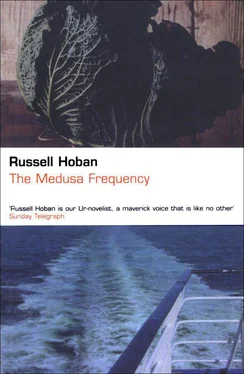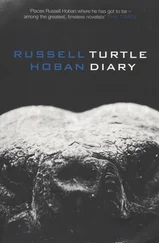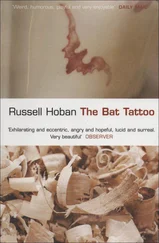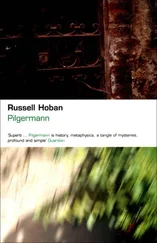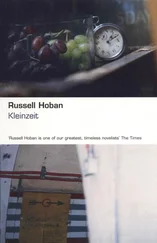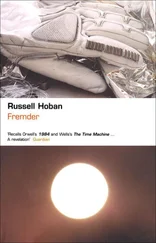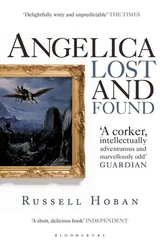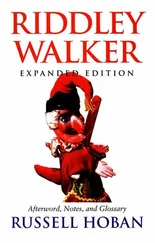‘No, the only Vermeer is this one.’ He indicated the reproduction on the cover of the catalogue.
‘Where’s the Head of a Young Girl?’
‘It’s on loan in America.’
‘Thank you.’ Pondering the complexity of this demonstration I went inside and made my way to the toiletten in the basement.
When I came back up the stairs I went into Zaal A where I found myself looking at two panels attached to each other, Nos 843a and 843b, a diptych, evidently, by G. David (1460–1523). Two narrow vertical panels offering a dark wood, many leaves, a stream, a donkey, a bird, two oxen, a road, a stone building with a tower or a silo. A mill? Unlikely. The word hospice came into my mind. Did the stream flow under an arch and into the building? Or did the road glitter, did the road flicker and shine not like a road? The dancing beast of the mystery, was it in this mystic wood? What a dark whispering in those many leaves! Come and find me, she had said. In this dark and whispering wood?
It occurred to me then that this Witthuis, this new abode, was a place that the Vermeer girl had physically departed from. She’d gone away over the water. Out of her Witts? Away from wittingness, perhaps; beyond the reach of intellect. Her old dwelling-place had been the Mauritshuis. I had no Dutch dictionary but I had my pocket German Langenscheidt with me so I looked to see if there was anything close to Maurits in German. Maurer was bricklayer, mason. The number of the railway carriage in which I had travelled here from the Hook of Holland had been 727. G is the seventh letter of the alphabet, B the second. GBG: GIRL BECOMES GONE. The Vermeer girl had moved from the house of bricks, of gross earthy matter, to the house of wits, of the mind, but intellect proving barren she had become gone while Hermes for a joke sent me to find her. No, it wasn’t just Hermes — she herself had told me to come and find her and in some way not yet revealed to me this was the place where she would be found, I could feel it.
I looked in my catalogue to see what it had to say about this dark wood painted by G. David. There was no mention of it whatever. I went to the man at the desk. ‘Those two panels by David,’ I said, ‘843a and 843b, they’re not in the catalogue.’
‘No,’ he said, shaking his head, ‘they’re not. They’re in the catalogue that’s in the shop.’
‘Where’s the shop?’
‘Through there.’
I went to the shop and bought the Mauritshuis Illustrated General Catalogue and a postcard of the Vermeer girl. Two French schoolgirls were buying the same postcard. ‘But where is this painting?’ one of them asked the man at the counter. ‘We can’t find it.’
‘It’s in America.’
‘When does it return?’
‘Next year.’
Turning in the catalogue to David, No. 843, I read:
David, Gerard
Born ca 1460 in Oudewater, died 1523 in Bruges. Worked in Bruges, where he was the most important artist after the death of Memling.
Two forest scenes
P. each 90 × 30·5. The versos of the wings of a triptych; the left one with a donkey, the right one with two oxen. Ox and donkey recur in the middle panel. The latter, depicting the Adoration of the child and the rectos of the wings are in the Metropolitan Museum in New York.
I went back to Zaal A and stared at the two panels. A space suggested itself between them and I waited to see what would appear in the space.
Someone was looking over my shoulder. I turned and saw a tall thin man with a large light-bulb-shaped bald head and those drooping oldtime-gunfighter moustaches much favoured by American television actors. From the hang of his face however I guessed him to be European, possibly Scandinavian. He seemed to be drawing himself up into his head preparatory to speaking, and as I was the only other person in the room I waited to hear what he would say.
‘Rectos no,’ he said. ‘Mmnvs? Everything is metaphor and metaphor is the only actuality. Here we have the versos of the wings of a triptych, here we have only the other sides of the missing rectos that when folded shut covered the Adoration of the child. Mmnvs. Nnvsnu rrndu.’
‘Did I understand you to say nnvsnu rrndu?’ I said.
‘Mmnvs.’
‘You’re thinking of existing?’
His head seemed to grow larger and balder and more light-bulb-shaped. ‘You observe me, sir,’ he said. ‘You observe me consistently and three-dimensionally manifesting, with aplomb, myself both as picture and sound. Do you not?’
‘I do.’
‘I revert to the tremendour of this metaphor, the other-sideness of versos without rectos and the child gone missing, out of our sight, offering only its rejection of our potential adoration.’
‘“Tremendour.” I haven’t heard that before.’
‘Tsrungh. From its otherness of place it speaks the encrustation, the palimpsest, the ultimate dialectic of what Redon called “the deep health of the black”. This is where I get my jollies; I am a creature of the deeps.’
‘Says who?’
‘Says Sight and Sound for one. They did an eight-page piece about my work: “The Unslumbering Kraken”.’
‘I’ve stopped reading Sight and Sound, I don’t think film people should be allowed near words, it’s bad for everybody.’
‘I agree completely. I speak only in pictures. With me the image is everything, carrying within it as it does the protoimage, the after-image, and the anti-image. This is why here I have come to speak to the Vermeer girl and to hear what she will say to me but alas, she is gone over the water and here I stand looking at this enchanted wood with its missing rectos and its centre that could not be held. This utters to me most powerfully.’
‘What did you want with the Vermeer girl?’
‘I’m in love with her. She is that aspect of the Mother Goddess that dominates my being, my perception, my innermost and uttermost blackness, my seminal vesicles. She is the proto-image of the femaleness of things; always have I spoken to her in the whispering of the night, in that warm and creatureful darkness where the flickering of the here-and-gone shows its little uncertain flame.’
‘Have you no shame? How can you say such things in a public place to someone you’ve never seen before? You don’t even know my name.’
‘That signifies not at all; you know my name.’
‘No I don’t.’
‘I’ve told you it: Kraken, Gösta Kraken as you know very well. Not for one moment do I believe that you’ve stopped reading Sight and Sound. From the faltering cadence of your stare I perceive that you recognize me from those many photographs of me in that publication and elsewhere. Fnss. The self-consuming antistrophe of your silence tells me that you resent my head of Orpheus swimming up the Thames.’
‘Faltering cadence of my stare! I’m not taking that from you, nor “self-consuming antistrophe” either. Don’t you come the deconstructionist with me, you ponce. I’ve never even seen your swimming head of Orpheus.’
‘Very well then, tell me your name. I can see that you will be fractally asymptotic in your resonances until we have spoken this out.’
‘My name is Herman Orff and you’ve never heard of me.’
‘Oh, but I have. Luise has mentioned you several times.’
There was an upholstered bench behind me. I sat down on it.’
‘Luise’, I said, ‘has mentioned.’
‘You. More than several times, reverberantly and with plangency.’
‘What is Luise to you?’
‘Lost. Gone. Two years only, then Znrvv! No more Luise. A note on the kitchen table like an unaccompanied cello in a studio with dusty windows.’
‘Don’t roll the credits over it; just tell me plangently when she left you.’
Читать дальше
